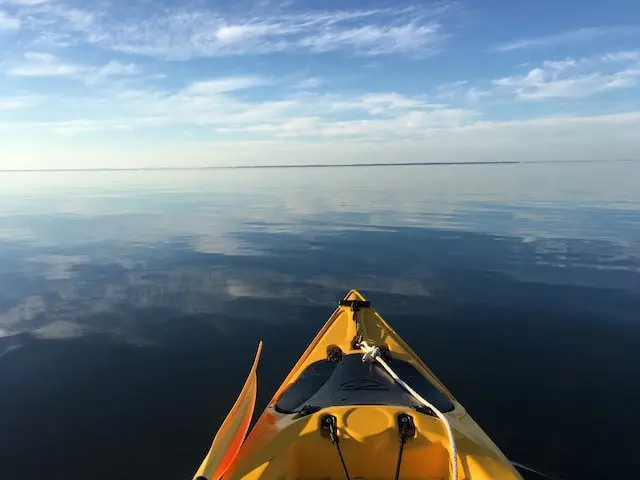Choose the Right Kayak
Sea kayaks are wider, longer and more stable than typical recreational kayaks. The extra width provides more balance to handle waves and cargo. When outfitted for sea kayaking, storage hatches and shock cord rigging allow packing extra gear and supplies needed for full-day trips. Sit-on-top designs with sealed compartments provide additional flotation if capsized. When selecting a sea kayak, make sure it fits your body type and skill level. Consider taking classes from a kayak outfitter to learn proper techniques for launching and handling.
Pack Light Yet Smart
When loading gear for a sea kayaking excursion, the key is to pack lightly yet strategically. Too much excess weight can make the kayak unstable and hard to navigate. Pack only essentials, balancing weight between the bow and stern to aid handling. Water, sun protection, first aid supplies, nautical charts and a signaling device should always be on board. Waterproof storage bags and tie-down straps will keep gear secure. Leave valuables and electronics at home to prevent damaging them if capsized. Traveling light is safer and allows covering more distance.
Master Kayaking Techniques
Paddling and steering a sea kayak utilizes specialized techniques to handle ocean swells and currents. Taking the time to master basic strokes like forward, reverse, sweeps and draws will give you better control in variable conditions. Learning bracing skills to avoid capsize is also key. Righting the kayak after flipping over requires practice in safe waters. Always carry flotation devices, bilge pump, paddle float and signal whistle in case of emergencies. Staying calm is critical when dealing with ocean mishaps.
Study Local Conditions
Before embarking on sea kayaking trips, research local wind, wave and tidal conditions you’ll encounter. Ocean environments can change rapidly, building dangerous surf or strong currents. Identify potential landing spots if needing to get ashore. Consult navigation charts to plan your paddling route, noting prominent coastal features and water depths. Share your float plan with someone remaining on land. Checking tide tables and weather forecasts allows choosing optimal launch times. Being prepared for conditions gives added safety margins out on seas.
Take a Safety Course
For beginners, taking sea kayaking classes or guided tours helps vastly improve skills and knowledge. A certified instructor teaches launch and landing methods, efficient paddling techniques, navigation and capsize recovery. They identify potential hazards to avoid based on current conditions. Safety courses also cover first aid, hypothermia prevention and communications for requesting emergency assistance. Learning proper procedures, protocols and regulations makes independent kayaking much less intimidating.
Start Small and Close to Shore
When first sea kayaking on your own, start with short trips staying fairly close to shore. This allows quickly getting to land if tiring or challenges arise. Paddle in good weather conditions with light winds and calm seas initially. Avoid large waves, surf zones, shipping channels and areas with strong currents that will sweep you out until more experienced. Stay close enough to shore to walk back if needed. Slowly work up to longer trips as your fitness and capability improves. Remain conservative until confident handling most conditions.
Invest in Quality Gear
A quality sea kayak designed for stability, reliable paddle suited for your height and purpose-built accessories make the sport much more enjoyable. A snug spray skirt keeps water out of the cockpit while allowing easy exit. A comfortable, adjustable seat aids proper paddling posture over longer trips. Sturdy thigh braces help control the kayak if temporarily capsized. Other handy accessories include secured deck rigging, protective spray decks, bilge pumps, paddle floats, helmets and specialty paddling apparel. Investing in proper gear improves safety margins and fun.
Practice Self and Buddy Rescues
Before venturing out alone, all sea kayakers should learn self-rescue techniques in case of emergencies. Practice capsizing then re-entering the kayak using proper body positioning and bracing. Also very useful is the paddle float deployment for reentry after flipping. Have an emergency communications plan if trouble arises. When kayaking with partners, do mock rescues to swiftly get distressed paddlers back into their boats. Remember to stay calm, focused and methodical when dealing with real emergencies during kayaking excursions.
Enjoy the Sea Kayaking Experience
Sea kayaking appeals to adventurous souls who enjoy exploring coastal regions up close from a unique water-level perspective. The sport provides great exercise with a chance to spot marine wildlife in their natural habitats. From rugged open ocean coasts to calm inland waterways, the diversity of destinations keeps paddling interesting. Sea kayaking satisfies while imparting self-confidence handling challenging conditions. Once fundamental skills are developed, a lifetime of rewarding adventures on seas, lakes and rivers awaits.
So be sure to select the right kayak, pack properly, learn essential techniques, study conditions, use quality gear and practice safety. Start small, paddle conservatively and build experience. Soon you’ll be confidently navigating and enjoying endless days exploring untold waters by sea kayak.
Edited: Dec 13, by Adminai
